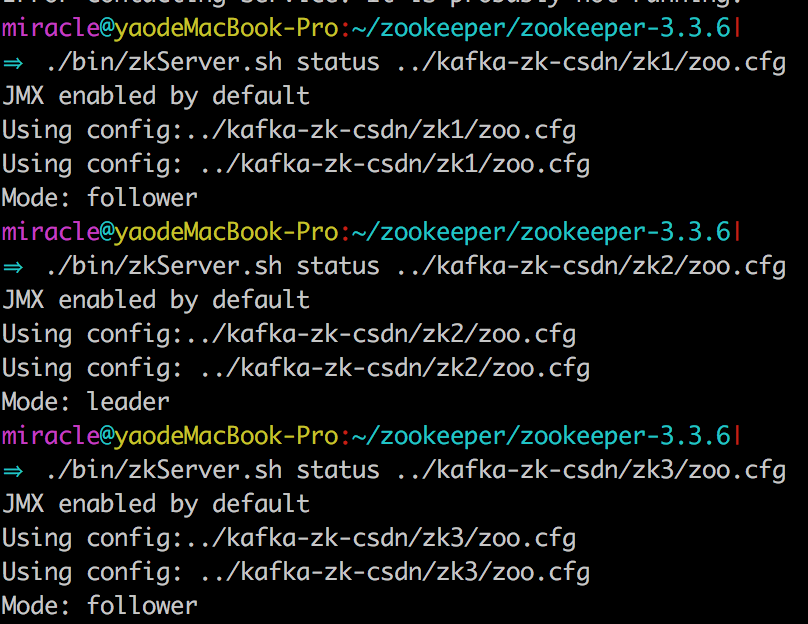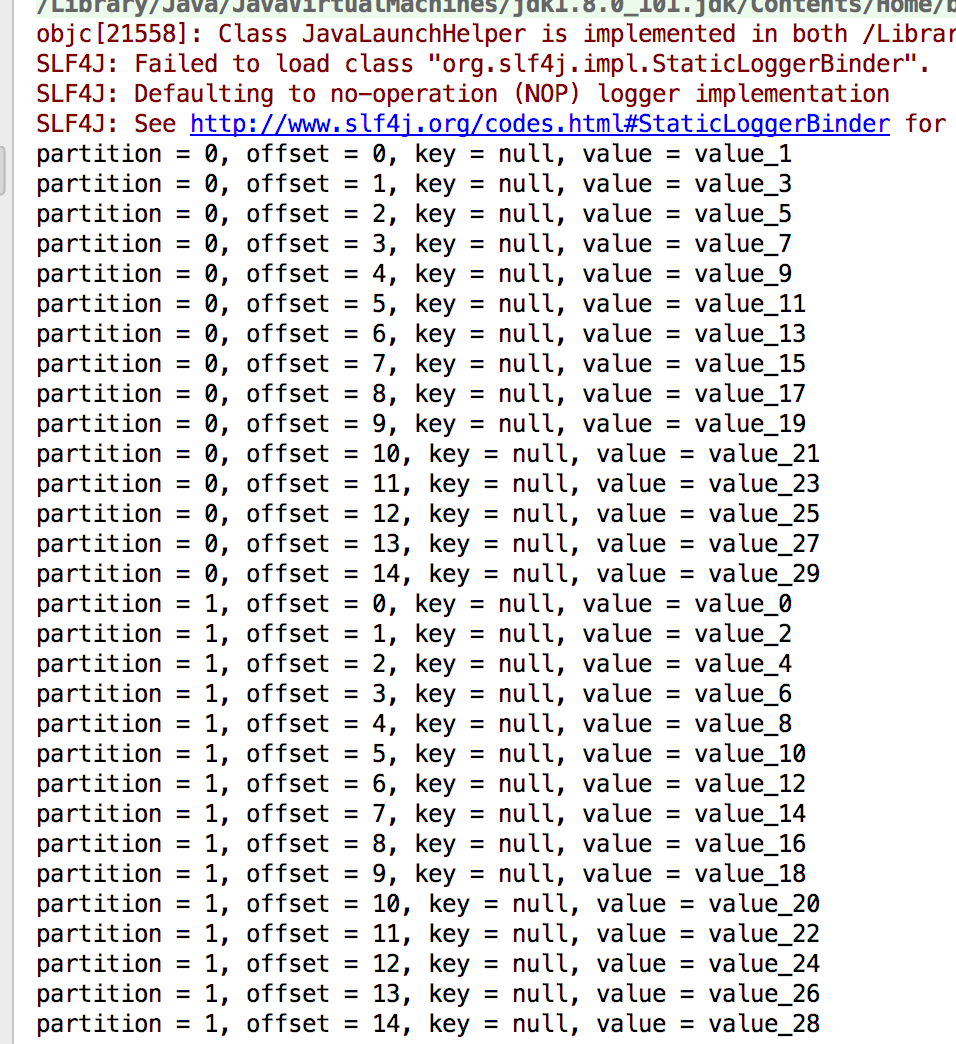【Kafka】使用非自帶zookeeper Java API 例子
這裡沒有使用kafka自帶的zk。
1.啟動zk:
zk下載解壓至任意資料夾。新建kafka-zk-csdn資料夾。這裡啟動包含三個節點的zk偽叢集,進入kafka-zk-csdn資料夾,新建zk1,zk2和zk3資料夾。
kafka-zk-csdn:
--zk1
--data
--myid
--log
--zoo.cfg
--zk2
--data
--myid
--log
--zoo.cfg
--zk3
--data
--myid
--log
--zoo.cfg
每一個資料夾下新建data資料夾,在data資料夾下新建myid檔案,內容分別為1,2,3,表示zk節點id。新建log資料夾,並且新建zoo.cfg配置檔案。內容如下:
zk1:
initLimit=10
syncLimit=5
dataDir=/Users/miracle/zookeeper/kafka-zk-csdn/zk1/data
dataLogDir=/Users/miracle/zookeeper/kafka-zk-csdn/zk1/log
clientPort=2181
server.1=127.0.0.1:2222:2225
server.2=127.0.0.1:3333:3335
server.3=127.0.0.1:4444:4445zk2:
initLimit=10 syncLimit=5 dataDir=/Users/miracle/zookeeper/kafka-zk-csdn/zk2/data dataLogDir=/Users/miracle/zookeeper/kafka-zk-csdn/zk2/log clientPort=2182 server.1=127.0.0.1:2222:2225 server.2=127.0.0.1:3333:3335 server.3=127.0.0.1:4444:4445
zk3:
initLimit=10
syncLimit=5
dataDir=/Users/miracle/zookeeper/kafka-zk-csdn/zk3/data
dataLogDir=/Users/miracle/zookeeper/kafka-zk-csdn/zk3/log
clientPort=2183
server.1=127.0.0.1:2222:2225
server.2=127.0.0.1:3333:3335
server.3=127.0.0.1:4444:4445前兩個配置是必須的,沒有啟動報錯。dataDir和dataLogDir目錄路徑自行修改。clientPort是客戶端訪問的埠。server.x.A.B中,x表示myid節點的id,A表示主節點和從節點通訊的埠,B表示主節點掛了選舉使用的埠。
接著使用如下命令啟動zk叢集:
./bin/zkServer.sh start ../kafka-zk-csdn/zk1/zoo.cfg
./bin/zkServer.sh start ../kafka-zk-csdn/zk2/zoo.cfg
./bin/zkServer.sh start ../kafka-zk-csdn/zk3/zoo.cfg可以使用status命令檢視是否啟動:
./bin/zkServer.sh status ../kafka-zk-csdn/zk1/zoo.cfg
./bin/zkServer.sh status ../kafka-zk-csdn/zk2/zoo.cfg
./bin/zkServer.sh status ../kafka-zk-csdn/zk3/zoo.cfg如上資訊表明zk叢集啟動成功。
2.啟動kafka:
這裡啟動 兩個broker,進入kafka的目錄。在config目錄下新建一個server-test-csdn目錄存放配置,進入該目錄下,新建server1.properties:
# Licensed to the Apache Software Foundation (ASF) under one or more
# contributor license agreements. See the NOTICE file distributed with
# this work for additional information regarding copyright ownership.
# The ASF licenses this file to You under the Apache License, Version 2.0
# (the "License"); you may not use this file except in compliance with
# the License. You may obtain a copy of the License at
#
# http://www.apache.org/licenses/LICENSE-2.0
#
# Unless required by applicable law or agreed to in writing, software
# distributed under the License is distributed on an "AS IS" BASIS,
# WITHOUT WARRANTIES OR CONDITIONS OF ANY KIND, either express or implied.
# See the License for the specific language governing permissions and
# limitations under the License.
# see kafka.server.KafkaConfig for additional details and defaults
############################# Server Basics #############################
# The id of the broker. This must be set to a unique integer for each broker.
broker.id=0
############################# Socket Server Settings #############################
# The address the socket server listens on. It will get the value returned from
# java.net.InetAddress.getCanonicalHostName() if not configured.
# FORMAT:
# listeners = listener_name://host_name:port
# EXAMPLE:
# listeners = PLAINTEXT://your.host.name:9092
#listeners=PLAINTEXT://:9092
listeners=PLAINTEXT://127.0.0.1:9096
# Hostname and port the broker will advertise to producers and consumers. If not set,
# it uses the value for "listeners" if configured. Otherwise, it will use the value
# returned from java.net.InetAddress.getCanonicalHostName().
#advertised.listeners=PLAINTEXT://your.host.name:9092
# Maps listener names to security protocols, the default is for them to be the same. See the config documentation for more details
#listener.security.protocol.map=PLAINTEXT:PLAINTEXT,SSL:SSL,SASL_PLAINTEXT:SASL_PLAINTEXT,SASL_SSL:SASL_SSL
# The number of threads that the server uses for receiving requests from the network and sending responses to the network
num.network.threads=3
# The number of threads that the server uses for processing requests, which may include disk I/O
num.io.threads=8
# The send buffer (SO_SNDBUF) used by the socket server
socket.send.buffer.bytes=102400
# The receive buffer (SO_RCVBUF) used by the socket server
socket.receive.buffer.bytes=102400
# The maximum size of a request that the socket server will accept (protection against OOM)
socket.request.max.bytes=104857600
############################# Log Basics #############################
# A comma seperated list of directories under which to store log files
log.dirs=/tmp/kafka-logs1
# The default number of log partitions per topic. More partitions allow greater
# parallelism for consumption, but this will also result in more files across
# the brokers.
num.partitions=2
# The number of threads per data directory to be used for log recovery at startup and flushing at shutdown.
# This value is recommended to be increased for installations with data dirs located in RAID array.
num.recovery.threads.per.data.dir=1
############################# Internal Topic Settings #############################
# The replication factor for the group metadata internal topics "__consumer_offsets" and "__transaction_state"
# For anything other than development testing, a value greater than 1 is recommended for to ensure availability such as 3.
offsets.topic.replication.factor=1
transaction.state.log.replication.factor=1
transaction.state.log.min.isr=1
############################# Log Flush Policy #############################
# Messages are immediately written to the filesystem but by default we only fsync() to sync
# the OS cache lazily. The following configurations control the flush of data to disk.
# There are a few important trade-offs here:
# 1. Durability: Unflushed data may be lost if you are not using replication.
# 2. Latency: Very large flush intervals may lead to latency spikes when the flush does occur as there will be a lot of data to flush.
# 3. Throughput: The flush is generally the most expensive operation, and a small flush interval may lead to exceessive seeks.
# The settings below allow one to configure the flush policy to flush data after a period of time or
# every N messages (or both). This can be done globally and overridden on a per-topic basis.
# The number of messages to accept before forcing a flush of data to disk
#log.flush.interval.messages=10000
# The maximum amount of time a message can sit in a log before we force a flush
#log.flush.interval.ms=1000
############################# Log Retention Policy #############################
# The following configurations control the disposal of log segments. The policy can
# be set to delete segments after a period of time, or after a given size has accumulated.
# A segment will be deleted whenever *either* of these criteria are met. Deletion always happens
# from the end of the log.
# The minimum age of a log file to be eligible for deletion due to age
log.retention.hours=168
# A size-based retention policy for logs. Segments are pruned from the log unless the remaining
# segments drop below log.retention.bytes. Functions independently of log.retention.hours.
#log.retention.bytes=1073741824
# The maximum size of a log segment file. When this size is reached a new log segment will be created.
log.segment.bytes=1073741824
# The interval at which log segments are checked to see if they can be deleted according
# to the retention policies
log.retention.check.interval.ms=300000
############################# Zookeeper #############################
# Zookeeper connection string (see zookeeper docs for details).
# This is a comma separated host:port pairs, each corresponding to a zk
# server. e.g. "127.0.0.1:3000,127.0.0.1:3001,127.0.0.1:3002".
# You can also append an optional chroot string to the urls to specify the
# root directory for all kafka znodes.
zookeeper.connect=localhost:2181
# Timeout in ms for connecting to zookeeper
zookeeper.connection.timeout.ms=6000
############################# Group Coordinator Settings #############################
# The following configuration specifies the time, in milliseconds, that the GroupCoordinator will delay the initial consumer rebalance.
# The rebalance will be further delayed by the value of group.initial.rebalance.delay.ms as new members join the group, up to a maximum of max.poll.interval.ms.
# The default value for this is 3 seconds.
# We override this to 0 here as it makes for a better out-of-the-box experience for development and testing.
# However, in production environments the default value of 3 seconds is more suitable as this will help to avoid unnecessary, and potentially expensive, rebalances during application startup.
group.initial.rebalance.delay.ms=0同時新建server2.properties,內容同上,但是做如下修改:
broker.id=1
listeners=PLAINTEXT://127.0.0.1:9097
log.dirs=/tmp/kafka-logs2執行命令啟動:
bin/kafka-server-start.sh config/server-test-csdn/server1.propertiesbin/kafka-server-start.sh config/server-test-csdn/server2.properties上述命令是阻塞式的,執行一條命令需要新開一個終端。
沒有報錯說明啟動成功。
3.JAVA Api。這裡使用的kafka 2.11版本。
上面啟動了兩個broker,且配置分割槽數目為2。
pom:
<!-- https://mvnrepository.com/artifact/org.apache.kafka/kafka -->
<dependency>
<groupId>org.apache.kafka</groupId>
<artifactId>kafka_2.11</artifactId>
<version>1.1.0</version>
</dependency>生產者:
package a;
import org.apache.kafka.clients.producer.KafkaProducer;
import org.apache.kafka.clients.producer.Producer;
import org.apache.kafka.clients.producer.ProducerRecord;
import java.util.Properties;
public class Prod {
public static String topic = "kafka-topic";
public static void main(String[] args) {
Properties props = new Properties();
props.put("bootstrap.servers", "127.0.0.1:9096,127.0.0.1:9097");
props.put("acks", "all");
props.put("retries", 0);
props.put("batch.size", 16384);
props.put("linger.ms", 1);
props.put("buffer.memory", 33554432);
props.put("key.serializer", "org.apache.kafka.common.serialization.StringSerializer");
props.put("value.serializer", "org.apache.kafka.common.serialization.StringSerializer");
Producer<String, String> procuder = new KafkaProducer<String,String>(props);
for (int i = 0;i < 30;i++) {
String value = "value_" + i;
ProducerRecord<String, String> msg = new ProducerRecord<String, String>(topic, value);
procuder.send(msg);
try {
Thread.sleep(1000);
} catch (InterruptedException e) {
e.printStackTrace();
}
}
}
}
消費者:
package a;
import org.apache.kafka.clients.consumer.ConsumerRecord;
import org.apache.kafka.clients.consumer.ConsumerRecords;
import org.apache.kafka.clients.consumer.KafkaConsumer;
import java.util.*;
public class Consu {
public static void main(String args[]){
Properties props = new Properties();
props.put("bootstrap.servers", "127.0.0.1:9096");
props.put("group.id", "g2");
props.put("zookeeper.session.timeout.ms", "400");
props.put("zookeeper.sync.time.ms", "200");
props.put("auto.commit.interval.ms", "1000");
props.put("auto.offset.reset", "earliest");
props.put("key.deserializer", "org.apache.kafka.common.serialization.StringDeserializer");
props.put("value.deserializer", "org.apache.kafka.common.serialization.StringDeserializer");
KafkaConsumer<String, String> consumer = new KafkaConsumer<>(props);
consumer.subscribe(Arrays.asList(Prod.topic));
while (true) {
ConsumerRecords<String, String> records = consumer.poll(100);
for (ConsumerRecord<String, String> record : records)
System.out.printf("partition = %d, offset = %d, key = %s, value = %s%n", record.partition(), record.offset(), record.key(), record.value());
}
}
}
截圖:
消費者傳送的訊息確實是傳送到了兩個分割槽中,具體規則在下一篇分割槽中總結。
Kafka的API每一版本都有更新,這裡是2.11版本的。


